Hike of the Seeadler sailing raider, or How did the count become a corsair
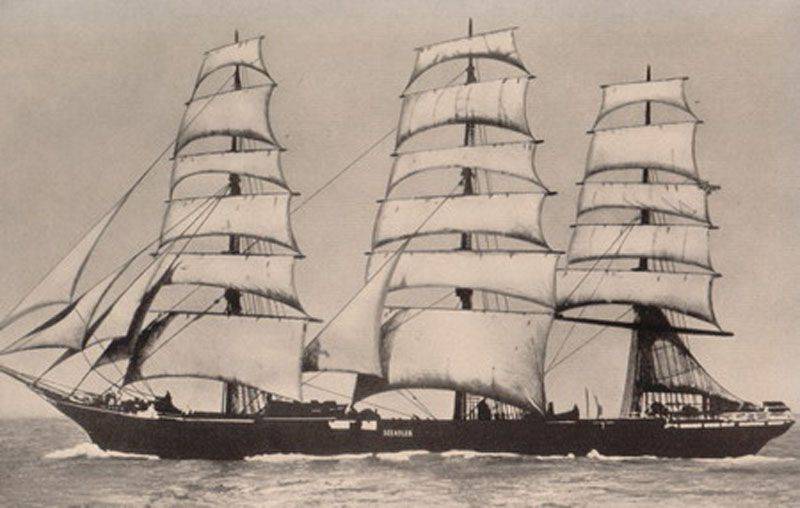
Balagur and merry fellow, captain of the Norwegian sailboat “Gero” possessed to himself. He chewed tobacco, poisoned trifling bikes, funnyly mangling English words and at the right moments screwing salty curses into the conversation. The officer of the inspection party of the British auxiliary cruiser Avenger, himself called up from the reserve, nodded with understanding while listening to his colleague. In the recent storm, “Gero” got tight - the water hit the captain's cabin, soaking documents and logbooks. About this testified and some chaos prevailing on the sailboat. Sullen bearded men, who occasionally quarrel among themselves in this ear-scandinavian language, leisurely fumbled on the deck. The Norwegian captain was so kind that he treated his English guest with a glass of excellent rum, the aroma of which, however, smelt strongly of himself. The Englishman was no less gracious and warned Captain Gero of the possible appearance of German auxiliary cruisers in the Atlantic. Wishing each other a merry Christmas and a happy voyage, the officer of the Avenger and his sailors fell away from the side of the Gero. When the boat moved away a sufficient distance, the captain cursed firmly. In German. They were lucky - the doors to the Atlantic were open. 1916 year ended. December, Christmas.
The Dead Past is the Living Present
The first campaigns of the German auxiliary cruisers, especially the successful Meve raid, showed the effectiveness and, most importantly, the efficiency of ships converted from commercial ships. True, the Achilles' heel of any raider was his fuel supply: no matter how voluminous the coal bunkers were, they tended to be depleted. It remained to hope for rich trophies, but that was not all. Coal could not fly over the air, for its transshipment a number of conditions were necessary: a secluded place, a calm sea. And most importantly - time. High-autonomous auxiliary cruisers, of course, were good, but a radical decision was necessary: on the one hand, to further increase the cruising range of the raiders, on the other - to minimize their dependence on fuel stocks. Of course, the opinion of specialists first of all fell on the recently invented (1897 year) Rudolf Diesel engine, also called the “oil engine”. But there was no sufficiently powerful marine diesel engine capable of moving a large ocean vessel - even creating a ship power plant for “Deutschland” pocket battleships, the Germans faced a number of technical difficulties.
Coal raiders were too dependent on the quantity and quality of coal, there were no diesel raiders yet - and then the idea arose to shake antiquity and send a sailing ship that did not need fuel to hike. The main locomotive of this concept was a retired lieutenant fleet Alfred Kling. As a famous traveler, explorer of the Arctic, he carefully and consistently upheld the idea of using a sailboat as a raider. At first, this venture provoked a certain skepticism: in the age of steam, steel, electricity, sailing ships looked beautiful, romantic, but anachronistic. However, the number of more and more positive moments gradually began to outweigh the instructive voice of skeptics. The sailboat did not need fuel, therefore, had a sailing range limited only by provisions. Such a ship is easier to disguise. A relatively small auxiliary diesel engine, for example, designed for a submarine, would have been enough to move into the calm. Of course, the prospect of returning to Germany seemed rather dubious, but it was worth a try - after the Battle of Jutland, the Germans narrowed the number of instruments for effective warfare at sea to submarines and infrequent raids. The problem, of course, was that in the German fleet there were relatively few people with extensive sailing experience, and a man was needed - knowledgeable, skillful, courageous and daring. Able to lead such a very risky venture. And such a man was found - his name was Count Felix von Luckner, corvette captain of the fleet of His Imperial Majesty.
Daredevil Count
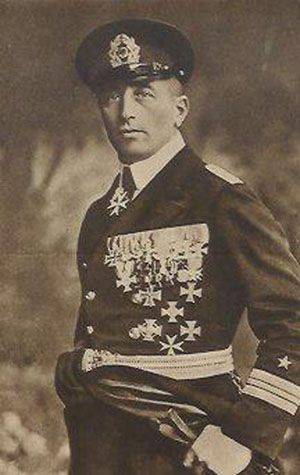
Felix von Luckner was a person so colorful that he deserves a separate opus. Coming from an old noble family, the great-grandson of the German Marshal of France, Nicolas Luckner. In 13 years, Felix escaped from his father's house. Since in those days the boys did not sit on Vkontakte and dreamed of something more interesting and dangerous than the sales manager’s chair, a quick graph under a false name recruited as a young man for food and berth to a Russian sailboat, Niobe, heading for Australia. Upon arrival, he escaped from the ship and went traveling. He sold books of the Salvation Army, worked in a circus, professionally boxed. Another Luckner happened to work as a keeper of the lighthouse, to serve as a soldier in the Mexican army of President Diaz, to visit an innkeeper and a fisherman.
At twenty, he entered the German nautical school, passed the exam, and in 1908, he received a navigator’s diploma and a place on the steamboat of Hamburg - South America. After nine months of service in the company, he enlisted in the Imperial fleet for a year to get an officer's rank. A year later, he returned to the same company, but at the top decided that such valuable personnel should be in the ranks, and in 1912, Luckner gets into the Panther gunboat, where he meets the war. Von Luckner is involved in several naval battles - Helgoland Bay, raids on the English coast. In the battle of Jutland, the count commands the main caliber on the battleship Kronprinz. In the officer corps he is considered a rude dork and an upstart. With his background and biography, Luckner secured an acquaintance with Kaiser Wilhelm himself. He also visited the imperial yacht. When the Admiral scale decided to equip the sailboat as an auxiliary raider, a better candidate than Luckner, it was difficult to find. Colleagues in the service grumbled that some ship was entrusted to some corvette-captain, but to wash the bones to the daredevil in a cozy and large cabin of some dreadnought was one thing, and to take the reefs in the ocean was another.
Orlan prepares to fly
The commander was found, the case remained for the small - to find a suitable ship. And not some coastal pot for catching mackerel. A relatively large ocean sailboat was needed. The three-mast sailing ship "Pax of Balmah", built in England in the 1888 year and sold in the USA, got into the field of view of the organizers of the campaign. In June 1915, he was captured by the German U-36 submarine and brought to Cuxhaven as a trophy by a prize party consisting of one (!) Fenrich, that is, a cadet. First, the Pax of Balmaha, renamed the Walter, was added as a training ship. 16 July 1916, it was decided to convert it into a raider.
The ship underwent a major overhaul - two 105-mm guns were installed on it, hidden in gunwale at the side of the forecastle. Equipped cellar ammunition. The future raider received a powerful walkie-talkie, in its hold were arranged premises for approximately 400 man from the crew of the captured ships. A very exotic addition, made at the insistence of Luckner, was a hydraulic elevator in the aft cabin. By pressing a special button, the cabin floor went down on one deck. According to the experienced graph, this could, in the event of force majeure, detain uninvited visitors. As an auxiliary propulsion unit, a diesel engine and propeller were installed on the sailboat. According to calculations, he could provide a course of up to nine knots. Space was provided for additional supplies and a spare spar. The ship was named "Seeadler" (Orlan). In addition to the material and technical preparation for the campaign, much time was devoted to masking the raider, which was of great importance. The British naval blockade grew stronger, and even a sailboat slipped through enemy patrols was quite difficult. Almost impossible. Therefore, "Seeadler" was supposed to wear a mask. At first, a similar Norwegian “Maleta” was considered, from whom he managed to steal logbooks while standing in Copenhagen. The raider was not only repainted - his internal premises were camouflaged. In the cabins of the sailors were hung photographs taken in a Norwegian photo studio, a set of navigation instruments, books and records in the cabins and officers' cabins, part of the provisions were also of Norwegian production. Twenty people were chosen from among the crew who spoke a language, who were supposed to represent the deck crew.
When all preparations were completed, Luckner received an order to wait for the return of the German submarine Deutschland, which was making a commercial flight, from the USA. The British doubled the patrols, trying to intercept the transport submarine. The likelihood to please in the network of the enemy increased. I had to wait twenty days, but during this time the real “Maleta” left Copenhagen at sea. The whole legend crumbled like a house of cards. Break the entire directory of Lloyd, Luckner found another ship, similar to the Seeadler, the sailboat Carmoe. While making the appropriate changes in the camouflage and the legend, it turned out that the true "Carmoe" was inspected by the British. Everything collapsed a second time. Spitting on failure, the desperate graph renames his ship into the fictional “Hero”, hoping that the British are not so careful in studying the Lloyd’s reference books. Properly patched stolen “Malety” logbook and the same ship-borne ship's documents were designed for the inspection party to read everything that was needed, but didn’t pick it out too much. In many ways, it was pure adventure, but Lucker was not the first to risk. 21 December 1916 of the year, taking all the stocks, Seeadler left the mouth of the Weser river. There were seven officers and 4500 sailors aboard the 57-ton sailboat.
"In the flibusterskom far blue sea" new raider sails
Luckner planned to go along the Norwegian coast, then go around Scotland from the north and go to the Atlantic by the usual ship route. December 23 Seeadler hit a violent storm that its commander marked as a good sign. Now it was not necessary to invent a reason for the British, why the ship's documents and the magazine are dampened. On Christmas, 180 miles from Iceland, the raider was stopped by the British auxiliary cruiser Avenger armed with eight 152-mm guns. With such a battery, even if it wasn’t new guns, an Englishman could have planed chips from a German sailboat in minutes. Therefore, the entire calculation was on a carefully prepared and rehearsed theatrical performance. On the deck piled up a sham of a forest that was allegedly transported by a pseudo-Norwegian. The British were not burdocks and watched Seeadler quite thoroughly. But the Germans played their roles well: Luckner was a tipsy Norwegian skipper, and one of his officers, Lieutenant Leiderman (who served, by the way, before the war with Ferdinand Laesh, the famous owner of Flying P windjams), was a hospitable senior staff member. After seeing the "Norwegian", the British wished them a happy voyage and warned of a possible threat from the German submarines and auxiliary cruisers. The latter was listened to with intense attention. Avenger continued its guard service, and Seeadler began its ocean flight.
Having plunged into the ocean, the disguise was dropped - a decorative load of wood flew overboard, and the canvas capes were removed from the guns. Observers with powerful binoculars were sent to the Mars. 9 January 1917 of the year in 120 miles south of the Azores from a raider noticed a single-tube steamer, which went without a flag. With the Seeadler, a signal was requested to read the chronometer — a usual procedure for sailboats of that time that had not seen the coast for a long time. The steamer lowered its speed, and at that time a German military flag was raised on a harmless “Norwegian” barge, the bulwarks lowered and the shot rang out. The steamer not only did not stop, but tried to go in a zigzag manner, but the next projectile exploded in front of the bow, the third one flew over the deck. The ship stopped the cars and raised the flag of the English merchant fleet. Captain Gladys Royle, coming from Buenos Aires with a cargo of coal, arriving at Seeadler, said in surprise that he noticed the German flag only when the third shot sounded. Before that, the British thought that the “Norwegian” was attacking a submarine, and even began to perform anti-submarine zigzag. Secretly delighted with this confirmation of the thoroughness of the disguise, Luckner sent the boarding party, which set up the explosive charges, and Gladys Royle went to the bottom. Account has been opened.
The next day, January 19, observers found another steamer. The ship haughtily did not respond to all the signals of a sailboat, and then Luckner ordered to cut the stranger’s course, hoping that, in accordance with the rules, he would give way to the sailing ship and slow down. However, the ship lane forward, not even thinking to stop. Infuriated by such blatant rudeness, Luckner ordered to raise the German flag and open fire. "Landy Island" (the so-called impudent merchant) tried to escape, but the Germans opened rapid fire - after four hits, he stopped and began to lower the boats. Luckner demanded that the captain come on board with the papers, but this was not done. The Germans had to lower their boat. When the captain of the ship was brought to Seeadler by force, the following was revealed. The ship went with a cargo of sugar from Madagascar, and its owner wanted to make good money on it. When the shells began to fall into the vessel, the crew of the natives, throwing everything, rushed to the boats. And then Captain George Bannister himself took the helm. But one of the hits was interrupted by a shipwreck, the ship lost control - the sailors fled, leaving their captain. After learning the details and appreciating the courage of the Englishman, Luckner calmed down, and Landy Island was finished off with guns.
Seeadler continued to move south. On January 21, he captured and sank the French bark Charles Gounod, and on January 24 a small English schooner Perseus. On February 3, during a turbulent weather, a large four-masted bark "Antonin" was seen from the raider. For the sake of sporting interest, the Germans decided to arrange a small regatta - there were many daredevils in the crew who had served on the windjammers before the war and knew a lot about such fun. The wind grew stronger, the Frenchman began to clean the sails, fearing for their integrity. Luckner did not remove a shred - the Seeadler approached the side of a French barge, from which they looked at the "crazy Norwegian" in surprise. Suddenly, the German flag was raised, and the machine-gun burst turned the sails so protected by the captain of the "Antonin" as rags. After inspecting the loser of the bark race was sent to the bottom. February 9 raider captured and sank the Italian sailboat "Buenos Aires" with a load of saltpeter.
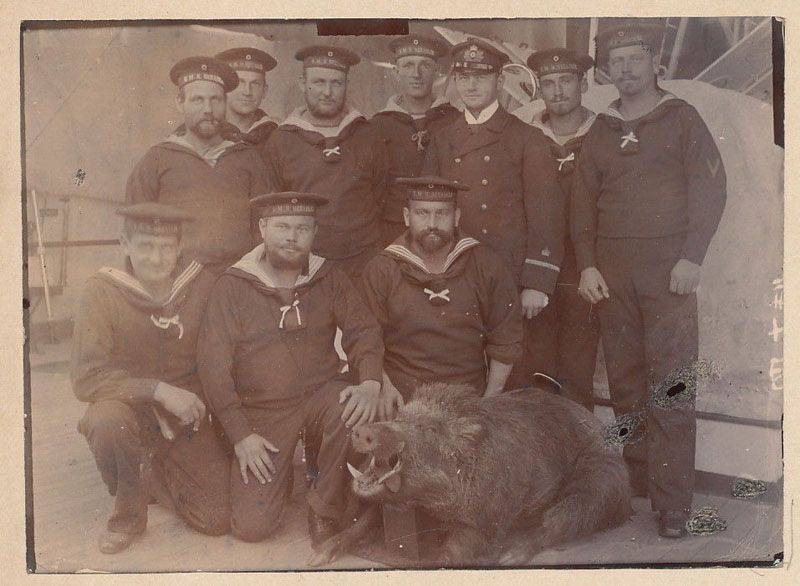
In the morning of February 19 an elegant large four-masted barque appeared on the horizon. Seeadler chased after him, the stranger accepted the challenge by adding sails. He was a good walker - the raider began to fall behind. Then the Germans started to help the auxiliary diesel, and the distance began to decrease. What was the surprise of Luckner himself when, in a stranger, he recognized the ship of his youth - the British bark “Pinmore”, in which he happened to go around Cape Horn. The war is merciless to the feelings of people and, obviously, decided to joke evil with the commander of "Seeadler." No matter how hard it was, but an old friend was sent to the bottom - to the raider he would be only a burden. On the morning of February 26 in the claws of the Orlan hit the bark of the “British Yomen”, whose name did not cause doubts in its nationality. "Yeomen" transported a variety of animals: chickens and piglets. Therefore, in addition to the crew, the Germans captured quite a few cackling and grunting prisoners, and then sunk their prize. In the evening of the same day, the French cargo bark “Laroshfuko” added to the collection of trophies of the German raider. February 27 named after the philosopher-moralist ship without too much philosophizing unceremoniously sank.
Next time, “Seeadler” was lucky on the evening of March 5. In fine weather, on the background of the moon, the signalmen saw the silhouette of a four-masted sailboat. Approaching a short distance, the Germans signaled: “Stop. German cruiser. Soon, the captain of the French barge "Duplet" Charnier climbed aboard in a very bad mood. He was just sure that he was the victim of someone's stupid joke or an awkward joke. All the jokes ended when the Frenchman saw a portrait of Emperor Wilhelm II on the wall in the cabin of Luckner. Charnier was very upset - a rumor was already crawling along the coast of South America that something was wrong at sea, merchant ships began to accumulate in the harbors. However, he did not wait for the shipowners instructions, but decided to take a chance and left the safe Valparaiso. The count showed sympathy and poured the enemy colleague an excellent trophy of French cognac. Duple was less fortunate - it was undermined.
March 11 on the eyes "Seeadler" after a series of sailing ships finally caught a large ship. As in their very first hunt, the Germans raised a signal asking them to indicate the time by chronometer. The steamer did not respond. Then, hunting for all sorts of fiction and improvisation, the count ordered to start a smoke generator prepared in advance, depicting a fire. At the same time, the signal flares were launched. The British imbued with such a dramatic picture and went to the rescue. When the steamer "Horngart" came closer, the Germans noticed an impressive weapon at its stern that could bring the wooden raider into serious trouble. It was necessary to act decisively, and most importantly, quickly. The distance between the ships decreased, the "fire" was suddenly brought under control. A specially-dressed sailor appeared on deck, waving affably to the approaching steamer. While the British were clapping their eyes, the bulwark sank and the 105-mm cannon aimed at the steamer, at the same time the German flag was raised. The captain of the "Horngarth" was not one of the timid, either, and refused to capitulate - the servants ran to the cannon. But it was not easy to resist Luckner and his floating theater troupe. A boarding team with headers and rifles jumped out onto the Seeadler's deck. For solidity, they immediately set up a machine gun. While on board the “Horngart” they were watching how some kind of unkind bearded men, suspiciously similar to the accomplices of captain Flint and Billy Bons, scurry about on a gloomy sailboat, a special noise gun fired from a pipe and filled with gunpowder fired from the raider. There was a terrible roar, at the same time the Germans fired from a real gun - the projectile demolished the radio station’s antenna. The culmination of the performance was the simultaneous roar of three people into megaphones: “Prepare torpedoes!” Such pressure, such expression was impossible to resist - the turmoil on the ship subsided, and the British waved white rags. After picking up several musical instruments from the obstinate steamer, including a piano for the mess room, the Germans sent him on a flight to Neptune.
March 21, capturing the French bark "Cambrnn", "Seeadler" replenished with provisions. Taking advantage of the fact that her Frenchman was abundant, Luckner decided to get rid of, finally, a large number of prisoners, which by this time there were already more than three hundred people. The content of such a crowd became overhead - ship stocks were destroyed at high speed. Yes, and guard the prisoners was troublesome. It was not possible to send “Cambronn” with the prize game - the raider’s crew was few in number. The Germans couldn’t provide the sailing ship into the hands of the captives either - it would quickly reach the coast and warn the enemy. Received slyly. At Kambronn, they simply cut down the branches, destroyed the spare mast and threw overboard the sail. Now the boat could reach the nearest port of Rio de Janeiro no earlier than ten days later. East of Trinidad, the Frenchman was released with the wishes of a happy voyage.
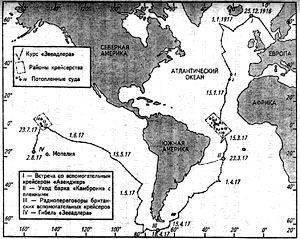
Having done things in the Atlantic, Luckner decided to change the region of activity. Seeadler moved south and April 18 skirted Cape Horn. The raider was so deep in these inhospitable latitudes that he even met several icebergs. Carefully advancing along the coast of Chile, the Germans managed to safely reach out to the auxiliary cruiser Otranto, known for having managed to survive in the extremely bad battle for the British at Cape Coronel, in which Maximilian von Spee defeated the English squadron of Admiral Cradock. In order to put down the vigilance of the enemy, Luckner resorted to another improvisation. Overboard were thrown boats and life jackets, previously removed from the sunk ships. The inscriptions "Seeadler" were made on them. At the same time, the radio of the raider transmitted several short messages that terminated halfway through with the SOS signal. Considering the west coast of South America rather dangerous place, Luckner decided to go to a more calm, free from enemy water patrols. In early June, the raider was in the area of Christmas Island in the Pacific Ocean, where his crew learned about the US entry into the war on the side of the Entente. The range of possible mining has increased. Already on June 14 was captured and burned - shells were saved - four-masted American schooner “A. Johnson. " Then two more American sailboats fell into the hands of Luckner.
In late July, the commander of the raider decided to give his team a rest, and at the same time to carry out some repairs to the Seeadler itself. The shortage of fresh water and fresh provisions began to be felt on board, which threatened scurvy. He anchored off the island of Mopelia from the archipelago of French Polynesia. It was quite deserted here, it was possible not only to sort out the ship diesel, but also to clean the bottom of the ship - for the long voyage Seeadler was thoroughly overgrown, which affected its speed characteristics.
Adventures of new robinsons
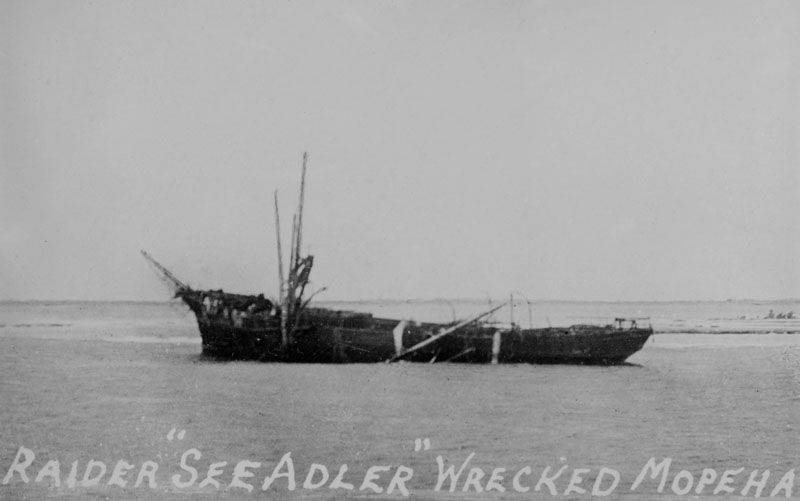
2 August 1917, an unexpected event put an end to the military career of the auxiliary cruiser. Von Luckner himself describes this in his pictorial memoirs as a sudden tsunami. According to him, in the morning of August 2, a sudden huge wave suddenly threw Seeadler onto reefs. It all happened so quickly that the Germans could not even start their diesel to take the ship out of the bay. Captured Americans later poisonously told another historyas if 2 August morning was really hard for the count and his team because of the fierce fighting with a green serpent, in which he won a convincing victory. The anchors of the Seeadler left unattended were crawling, and the raider carried the reefs astern. No data confirming the tsunami in the area has been preserved. The bottom line was sadly - Luckner and his people suddenly turned into island inmates. But the active nature of the experienced earl was uttered by the career of Robinson Crusoe looming in front of him and the crew, although Mopelia had water and a lot of vegetation, and the Germans managed to save most of the provisions and equipment. It seemed that you should sit on the bank and wait until you pick up - but no. On August 23, Luckner and five sailors took to sea in a lifeboat named after the “Crown Princess Cecilia” - this was the name of one of the German transatlantic airliners. The purpose of the journey was the Cook Islands, and if circumstances allow, then Fiji. The count was planning to capture some sailboat, return for his people and continue cruising.
26 August boat reached one of the Cook Islands. The Germans were posing as traveling Dutch. However, moving from island to island, Lucker did not manage to find a single any acceptable watercraft. The New Zealand administration began to suspect something about the suspicious Dutch, so the “travelers” considered it a blessing to go further. The transition to Fiji was difficult - the fragile shell of a boat was winding in tropical storms, its crew sizzled with the heat of the equatorial sun, lack of provisions and water led to scurvy. Finally, the extremely worn out “Crown Princess Cecilia” arrived at Wakaya Island, located near one of the largest islands in the Viti Levu archipelago. Barely recovering from the most dangerous and full of adversity campaign, the Germans decided to seize a small schooner with a load of clothing and provisions. Preparations for the assault were in full swing when a steamer arrived on the island with a group of armed policemen. The administration became aware of the arrival of dangling individuals with an unkind spark in their eyes, and she reported where to go. Luckner forbade his people to resist. The Germans did not have a military uniform, and, according to the laws of wartime, they could simply be hung on the nearest palm trees as ordinary thugs. On September 21, the commander of the Seeadler was taken prisoner along with his people.
In the fate of their comrades robinzonstvuyuschih on Mopelia, in the meantime, there was an unexpected turn. On September 5, the French schooner Lutezia approached the island. Left behind the senior officer, Kling began to give distress signals, his people dismantled weapon. The greedy Frenchman saw the wreckage of “Seeadler” and agreed to help for a third of the sum insured. The Germans happily agreed, "Lutetia" anchored, and a boat with armed sailors approached it ... The French were asked to clean the ship. Leaving the prisoners of the Americans on the island from the schooners captured by the Seeadler together with the French and their excessively caring captain, Kling led his trophy to the east. Three days later, the Japanese armored cruiser Izumo approached the atoll and was involved in the search for a German raider, who took the captives from the shore. It turned out that the “Lutetia” had previously belonged to the Germans and was called “Fortune” - the ship returned its former name. Kling planned to go to Easter Island and prepare the ship for the transition around Cape Horn - he was still hoping to return to his homeland. However, on October 4 1917, Fortune swooped in on a reef not marked on the map and was wrecked. The crew was able to get to Easter Island, where he was interned by the Chilean authorities until the end of the war.
Return of the prodigal graph
The tireless graph and in captivity was deprived of peace, which caused a lot of trouble. 13 December 1917, he and his people fled from New Zealand on a boat that belonged to the commandant of the prison camp. The boat was armed with a skillfully made mock machine gun. Luckner once again took the risk, deceiving and desperately bluffing. The Germans managed to capture a small moa schooner. The indomitable corsairs were already preparing to continue their march when a patrol ship approached the board of the Moa. His commander paid tribute to the courage and resourcefulness of the Germans, but very seriously proposed to stop naughty. Luckner sighed and agreed. He was captured again. Until the end of the war, he stayed in New Zealand. Count Felix von Luckner returned to Germany defeated in the Versailles Peace Treaty in 1919. By 1920, the entire crew of the Seeadler was already at home.
During the 244 day of the cruise, the last German auxiliary cruiser destroyed three steamboats and eleven sailboats with a total tonnage of more than 30 thousand tons. The idea of a disguised as a harmless sailboat raider fully justified. The Seeadler's wreck was inspected by former shipowners after the war, and its condition was deemed unsuitable for further restoration. Felix von Luckner lived a long and rich life. He died in the city of Malmo in Sweden 13 April 1966, at the age of 84 years. The raid of the sailing auxiliary cruiser at the height of the era of iron and steam was a unique experiment, and the only one left. As if times and heroes of Stevenson and Sabatini for a moment returned from the past, flashed into obscure silhouettes and melted in the ocean haze, like the era of the Jolly Roger, piastres and gentlemen of fortune.
Information